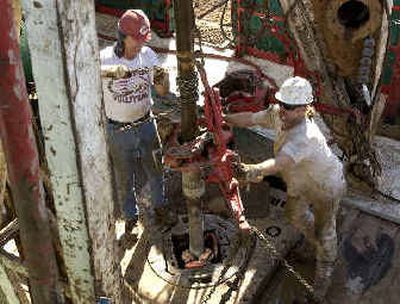Labor well is running dry

ZENDA, Kan. – Years after plummeting prices dismantled its infrastructure and decimated its work force, the nation’s oil and gas industry is contending with a labor shortage – just as demand and prices are soaring again.
Laid-off oil field workers long ago found more stable jobs elsewhere, and most are not returning. Especially hard to find are people to fill entry-level jobs as roustabouts, rig hands, pumpers and service personnel in Kansas and elsewhere in the country.
The severity of the shortage varies from region to region. It is harder to find oilfield workers for natural resource development in the Rockies and Appalachians than in Texas or the Gulf region, said Fred Lawrence, vice president of economics for the Independent Petroleum Association of America.
The worker deficit results from the domestic energy industry’s recovery following years of decline. Now that oil prices have climbed above $50 a barrel, rusty rigs that nobody wanted just a few years ago are being dragged out of equipment yards. New drilling companies are popping up.
In 1981, when oil prices were high, some 91,553 wells were drilled in the United States, Lawrence said. By the time prices bottomed out in 1999, just 18,465 wells were drilled.
But in the first 11 months of 2004, some 31,533 wells were drilled across the country, compared with 23,592 in the same period a year earlier.
Ed Cross, executive vice president of the Kansas Independent Oil and Gas Association, said the lack of workers is dragging down the recovery in the state’s oil and gas industry.
“Almost every oil and gas producer I talk to would like to do more,” Cross said. “They just can’t find enough hired help to do more.”
Among those stymied is Mark Shreve, president of Mull Drilling in Wichita. His firm, an exploration and production company, contracts with others to drill its wells. Three years ago, it typically took 30 to 45 days to begin drilling once Shreve had a contract with a driller. Without enough workers, it now takes eight to 12 months.
“Between 1988 and 1999, we were fighting oil prices that were in the $10-a-barrel range,” Shreve said. “In 1999, our company drilled six wells. This year, we will drill 30 wells.”
Among those who did come back to the booming oilfields of Kansas is David Kerns, who quit a well-paying job as a guard in a Norton County jail to work on a rig. Kerns had left the industry in 1996 after oil field work dried up. Now 58, Kerns was not sure he could still do the hard work on a rig at his age.
But his father and his grandfather were oil workers, as were his older brothers: “Generation after generation – it gets into your blood,” he said.
Many workers, though, have decided not to come back. And so the industry has been looking to the nation’s changing demographics to recruit workers – and increasingly finding them among Hispanic immigrants.
Among them is Key Energy Services, Inc., the nation’s largest well servicing company with locations in 17 states. About 60 percent of its 8,000-plus workers are Hispanic, said Lou Pugliaresi, the company’s manager of government affairs.
Driving the trend is the fact that much of the nation’s oil patch lies in areas with large Hispanic populations such as New Mexico, Texas, Arizona and Oklahoma.
The company has provided rigs for hands-on training and gotten grants from the Department of Labor for partnerships to open schools in New Mexico, Texas and Oklahoma during the past two years.
There may be a downside to the new wave of workers – AMI Risk Management in Wichita, which writes insurance coverage for drilling and servicing contractors, reported a big increases last year in its oilfield worker compensation claims in the Midwest.
Between 1998 and 2003, insurance premiums collected at AMI tripled as drilling activity picked up, said Ray Merz, executive vice president. But during the same time, claim losses quadrupled.
“There is a correlation between the lack of experience and the lack of training and a higher frequency of claims,” Merz said. “In other words, workers with less than six months of experience have a higher accident rate.”